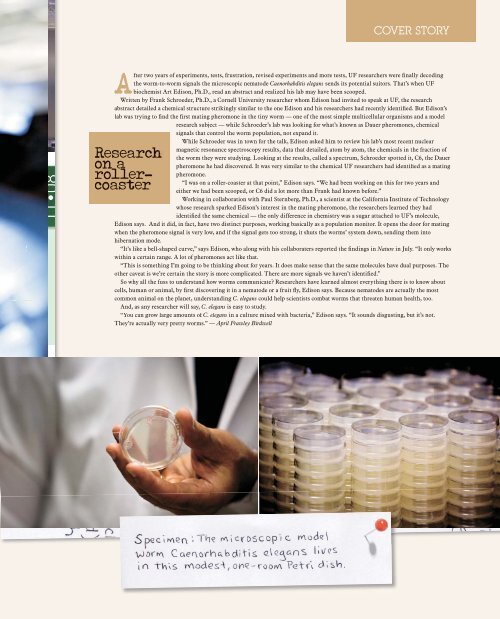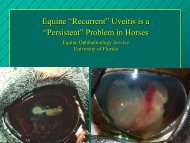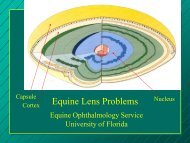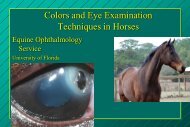DISSECTING - UF Health Podcasts
DISSECTING - UF Health Podcasts
DISSECTING - UF Health Podcasts
- No tags were found...
Create successful ePaper yourself
Turn your PDF publications into a flip-book with our unique Google optimized e-Paper software.
COVER STORYPastorey Birdwell,own Wright,wood, Johnhodenizer,er,11•08After two years of experiments, tests, frustration, revised experiments and more tests, <strong>UF</strong> researchers were finally decodingthe worm-to-worm signals the microscopic nematode Caenorhabditis elegans sends its potential suitors. That’s when <strong>UF</strong>biochemist Art Edison, Ph.D., read an abstract and realized his lab may have been scooped.Written by Frank Schroeder, Ph.D., a Cornell University researcher whom Edison had invited to speak at <strong>UF</strong>, the researchabstract detailed a chemical structure strikingly similar to the one Edison and his researchers had recently identified. But Edison’slab was trying to find the first mating pheromone in the tiny worm — one of the most simple multicellular organisms and a modelresearch subject — while Schroeder’s lab was looking for what’s known as Dauer pheromones, chemicalsignals that control the worm population, not expand it.While Schroeder was in town for the talk, Edison asked him to review his lab’s most recent nuclearmagnetic resonance spectroscopy results, data that detailed, atom by atom, the chemicals in the fraction ofthe worm they were studying. Looking at the results, called a spectrum, Schroeder spotted it, C6, the Dauerpheromone he had discovered. It was very similar to the chemical <strong>UF</strong> researchers had identified as a matingerpheromone.“I was on a roller-coaster at that point,” Edison says. “We had been working on this for two years andeither we had been scooped, or C6 did a lot more than Frank had known before.”Working in collaboration with Paul Sternberg, Ph.D., a scientist at the California Institute of Technologywhose research sparked Edison’s interest in the mating pheromone, the researchers learned they hadidentified the same chemical — the only difference in chemistry was a sugar attached to <strong>UF</strong>’s molecule,Edison says. And it did, in fact, have two distinct purposes, working basically as a population monitor. It opens the door for matingwhen the pheromone signal is very low, and if the signal gets too strong, it shuts the worms’ system down, sending them intohibernation mode.“It’s like a bell-shaped curve,” says Edison, who along with his collaboraters reported the findings in Nature in July. “It only workswithin a certain range. A lot of pheromones act like that.“This is something I’m going to be thinking about for years. It does make sense that the same molecules have dual purposes. Theother caveat is we’re certain the story is more complicated. There are more signals we haven’t identified.”So why all the fuss to understand how worms communicate? Researchers have learned almost everything there is to know aboutcells, human or animal, by first discovering it in a nematode or a fruit fly, Edison says. Because nematodes are actually the mostcommon animal on the planet, understanding C. elegans could help scientists combat worms that threaten human health, too.And, as any researcher will say, C. elegans is easy to study.“You can grow large amounts of C. elegans in a culture mixed with bacteria,” Edison says. “It sounds disgusting, but it’s not.They’re actually very pretty worms.” — April Frawley BirdwellResearchon aroller-coaster12•08 / 01•09POST 13
















